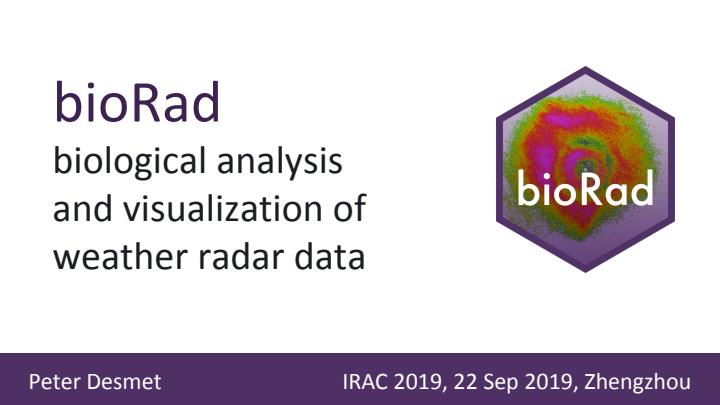bioRad: biological analysis and visualization of weather radar data
Details
| Type | Paper/Powerpoint/Abstract |
|---|---|
| Category | Research |
| Language | English |
Bibtex
@misc{42583066-3429-4da8-9ff9-ab029cbc27fb,
title = "bioRad: biological analysis and visualization of weather radar data",
abstract = "Weather surveillance radars are increasingly used for monitoring the movements and abundances of animals in the airspace. However, analysis of weather radar data remains a specialised task that can be technically challenging. Major hurdles are the difficulty of accessing and visualising radar data on a software platform familiar to ecologists and biologists, processing the low‐level data into products that are biologically meaningful, and summarizing these results in standardized measures. To overcome these hurdles, we developed the open source R package bioRad (described in Dokter et al. 2019, https://doi.org/10.1111/ecog.04028), which provides a toolbox for accessing, visualizing and analyzing weather radar data for biological studies. In this talk we will cover how bioRad provides functionality to access low‐level radar data, process these data into meaningful biological information on animal speeds and directions at different altitudes in the atmosphere, visualize these biological extractions, and calculate further summary statistics. We will also describe how the package introduces weather radar equivalents for familiar measures used in the field of migration ecology, facilitates the use and spread of interoperable data standards, and integrates with a research infrastructure for weather radar aeroecology in Europe and the United States.",
author = "Peter Desmet and Adriaan M Dokter and Jurriaan H. Spaaks and Stijn Van Hoey and Lourens Veen and Liesbeth Verlinden and Cecilia Nilsson and Günther Haase and Hidde Leijnse and Andrew Farnsworth and Willem Bouten and Judy Shamoun-Baranes",
year = "2019",
month = sep,
day = "22",
doi = "",
language = "English",
publisher = "Instituut voor Natuur- en Bosonderzoek",
address = "Belgium,
type = "Other"
}
Authors
Peter DesmetAdriaan M Dokter
Jurriaan H. Spaaks
Stijn Van Hoey
Lourens Veen
Liesbeth Verlinden
Cecilia Nilsson
Günther Haase
Hidde Leijnse
Andrew Farnsworth
Willem Bouten
Judy Shamoun-Baranes

